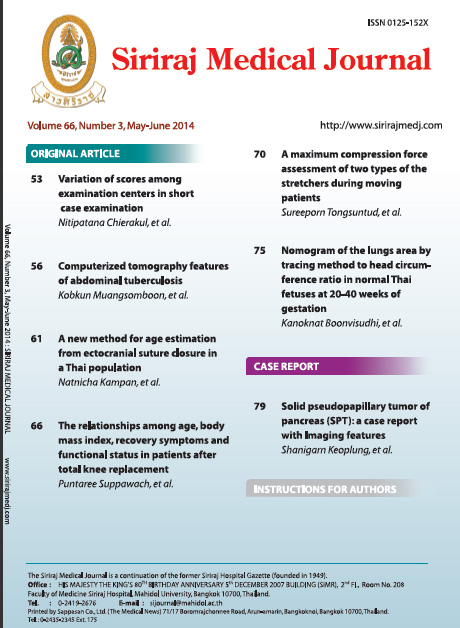Variation of Scores Among Examination Centers in Short Case Examination
Abstract
Objective: To evaluate the impact of patient selection process by examination center and examiner subjectivity on scores from the Royal College of Physicians Thailand (RCPT) short case examination.
Methods: Data of candidates who encountered short case examination as one part of clinical examination in RCPT board certifying examination in academic year 2010 were retrieved. For each examination center, overall scores given by internal and external examiners were compared. Among patient categories that were selected for the examination in all examination centers, comparison between scores in each category were also explored.
Results: There were 25 examination centers involved with 24 patient categories encountered. The mean score from internal and external examiners ranged from 64.0±17.1 to 77.8±14.4 and 65.6±18.9 to 77.4±15.4 respectively. Stringent site categori- zation as determined by lower scores from internal examiners were established in 11 examination centers, and, vice versa, 15 were categorized as lenient site. The lowest mean score difference in stringent sites was -4.9 and the highest from lenient sites was +4.7, but no statistical significances were reached (p = 0.088 and 0.106 respectively). There were 2 patient categories which yielded a significantly higher score and 1 patient category with lower score (p < 0.05).
Conclusion: In the current RCPT short case examination, the selected patient category appears to contribute variation in scores more than examiner subjectivity.
Keywords: Short case, patient selection process, examiner subjectivity Siriraj Med J 2014;66:53-55
Downloads
Published
How to Cite
Issue
Section
License
Authors who publish with this journal agree to the following conditions:
Copyright Transfer
In submitting a manuscript, the authors acknowledge that the work will become the copyrighted property of Siriraj Medical Journal upon publication.
License
Articles are licensed under a Creative Commons Attribution-NonCommercial-NoDerivatives 4.0 International License (CC BY-NC-ND 4.0). This license allows for the sharing of the work for non-commercial purposes with proper attribution to the authors and the journal. However, it does not permit modifications or the creation of derivative works.
Sharing and Access
Authors are encouraged to share their article on their personal or institutional websites and through other non-commercial platforms. Doing so can increase readership and citations.











